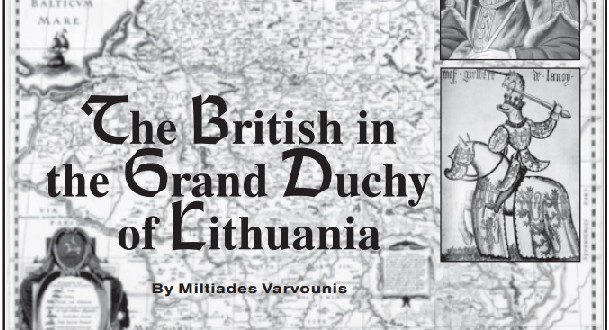By Miltiades Varvounis
The British in the Grand Duchy of Lithuania
For over five hundred years Britons have visited the Grand Duchy of Lithuania. Some came as warriors, others as diplomats, educators or traders, and still others as permanent settlers
BRITONS HAVE BEEN VISITING LITHUANIA AND Lithuanians Great Britain since the fourteenth century. While migration since 1795 and especially since 1991 was largely from Lithuania to Great Britain, between the sixteenth and eighteenth centuries, the movement had been more intense in the opposite direction.
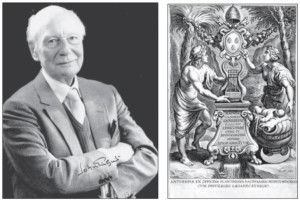
Lithuanians have contributed much to British culture and society. The renowned English thespian, Sir John Gielgud claimed descent from the Lithuanian Gelgaudas noble family, which fought for Lithuanian freedom from Russian tyranny in 1831 and again from 1863 to 1864. Lithuanian opera singers, such as Violeta Urmana and Edgaras Montvidas have proven a great success in opera productions for the Covent Garden and Royal Opera House. Dalia Ibelhauptaitė has directed opera and theater in London and taught master’s classes at the Royal National Theatre. The Lithuanian National Opera participated in Anthony Minghella’s production of Madam Butterfly. Some will be aware that the Scottish football club, Heart of Midlothian, is now owned by a Lithuanian company, while Lithuanians such as Tomas Danilevičius have played in the (English) Premier League. And let’s not forget the Lithuanian pilot Romas Marcinkus, who joined the Royal Air Force, defending Great Britain from German attack during WWII. After being captured by the Germans, he took part in the famous unsuccessful escape of Allied prisoners of war from Stalag Luft III in the spring of 1944, an event that was immortalized by John Sturges’s memorable 1963 film, The Great Escape. (It was also written up in the July/ August 2011 issue of Lithuanian Heritage – Ed.) But it was Motiejus Kazimieras Sarbievijus (Maciej Kazimierz Sarbiewski), a Polish-Lithuanian Baroque poet, who had the greatest impact on British culture. Known in his lifetime as the Christian Horace, his Latin poetry was also read, translated and imitated in Great Britain, especially from 1646 until the first half of the nineteenth century. Thanks to Sarbievijus, British poets started to imitate Horace, which was an important factor in overcoming the Pindaric tradition.
On the other hand, Britons have also contributed much to Lithuanian culture and society. Today, the majority of Lithuanians have likely heard or read about the presence of a Scottish community in the town of Kėdainiai, in central Lithuania, during the seventeenth century. But their knowledge regarding this topic, is probably limited to that detail. In the following article, we will concentrate on certain topics regarding the Britons who had migrated to or simply visited the Grand Duchy of Lithuania (GDL).
Royal Contacts and Envoys
For almost the entire fourteenth century, the Lithuanian crusades became a stalemate between the two powers, Lithuania and the Teutonic Order, a brutal war of raid and counterraid over an uninhabited, swampy and densely forested no man’s land. Supporting the Teutonic Order was quite fashionable for nobility from Western Europe. One of the most famous princes spending a season on crusade in Lithuania was Henry Bolingbroke (who was to rule England as Henry IV between 1399 and 1413). In 1390, he led a force of 300 Englishmen on the march to Vilnius with the Teutonic Knights. According to him, at that time the city was wooden and did not have a defensive wall, but boasted a stone castle. The attackers burned the city, but failed to seize the castle. One English chronicler claims, that during the siege, Boling- broke killed the brother of the Grand Duke of Lithuania. The brother of Jogaila, Prince Karigaila, who was among the defenders of the Vilnius Castle, did indeed perish.
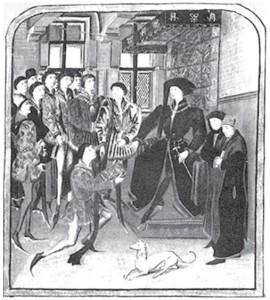
However, when the Lithuanian crusades were over, both countries established diplomatic relations. In the summer of 1419, the English Carmelite Provincial, Thomas de Balden, took part as the envoy of King Henry V in negotiating a peace between Lithuania, Poland and the Teutonic Order. The following year, Flemish knight Ghillebert de Lannoy (who was also in the official capacity of envoy for King Henry V) came to Lithuania, asking the support of Grand Duke Vytautas for a crusade against the Turks. De Lannoy was on his way to Syria and Egypt to resurrect the Kingdom of Jerusalem, the failed state of the early crusaders. A journey from England to the Middle East through Lithuania might seem long and difficult, but at this time, the vastly enlarged and politically stable GDL connected Latin Europe with the Islamic world as no other continental power did. This Flemish adventurer has left one of the most detailed descriptions we have of Vilnius, which was yet to resemble the stone-built and well-fortified town of a powerful European state. According to him, Vilnius’s “castle is built on a very high sandy hill and fortified with stone, earth and brick. Inside, it is all furnished with wood. The castle premises slope down on two sides of the high hill to its foot. Encircled with a brick wall, they contain many buildings. The aforementioned Duke Vytautas, the ruler of Lithuania, usually stays in the castle and its courtyard. He has his court and establishment there.”
The Tudor monarchs also maintained contacts with their Lithuanian counterparts. In 1500, Grand Duke Alexander invited King Henry VII to take part in a crusade against the formidable Ottoman Empire. However, Henry evaded the issue on grounds of financial caution. Correspondence between King Henry VIII and Grand Duke Sigismund the Old, showed that there were even plans to marry Grand Duke Sigismund Augustus off to Mary Tudor or even the future Queen Elizabeth (1547). In 1575, Sir Jerome Horsey, who led the English embassy to Vilnius, described with enthusiasm his stay with the Palatine of Vilnius and Chancellor of the GDL, Mikalojus Radvila Rudasis (Mikolaj Radziwiùù the Red).
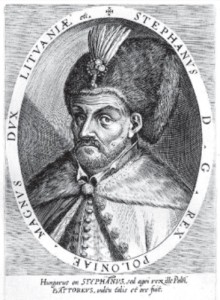
In 1671, King Charles II knighted a Scottish merchant in Lithuania, George Bennet, who became the king’s secretary. His son James studied at Vilnius University, and in 1674 he published an epic poem to celebrate the defeat of the Ottomans at the Battle of Khotyn (Turkish Chocim 1673), Virtus dexterae Domini. Finally, the royal contacts between both countries would be incomplete without mentioning the marriage of James Francis Stuart, the Old Pretender, to Clementina Maria Sobieska, the granddaughter of Jan III Sobieski, once Grand Duke of Lithuania and King of Poland.
Military Presence
English crusaders in Lithuania are noted in various records from 1329, with numbers clustering around the periods 1338-1370 and 1384-1394. Sir Geoffrey le Scrope of Marsham was killed in an attack on Kaunas in 1362 and buried with a memorial window in the church at Königsberg. Some English provincial churches contain memorials to men who took part in Lithuanian crusades. There are even major pieces of literature, both prose chronicles and poetry, like the notable Canterbury Tales, which mention these brutal crusades.
While mentioning the military presence of the Britons in the GDL, the descendants of the Anglo-Saxon warriors did not only face the Lithuanians in battle, but also enlisted as mercenaries in the Polish and Lithuanians armies. The first Polish-Lithuanian ruler to use foreign mercenaries (including the British) from both within and outside the multiethnic Polish-Lithuanian Commonwealth, was Grand Duke Stefan Batory (1576- 1586). Under his command, British mercenaries first saw action in the siege of Gdansk (1577). Scots were valued especially for their skill in musketry and, as Batory’s secretary noted, because they had “something above the Germans in willingness to fight and in bravery.” However, if someone imagines the Scottish mercenaries wearing the Highland tartan, he is mistaken. Surprisingly, the Scots wore fashionable European costume because the mid-seventeenth century tartan was regarded as primitive and uncivilized, not only abroad, but even in Scotland.
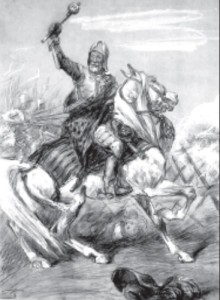
In the Polish-Swedish War (1600-1611), when the city of Parnü (Parnawa/Pernau) was besieged by the forces of the Lithuanian Grand Hetman Jonas Karolis Chodkevičius (Jan Karol Chodkiewicz), Scottish sappers were used to blow open the gate. When Parnü fell, a Scottish unit previously fighting for the Swedes, 155 men strong, commanded by Captain Clark, was asked by the Hetman to pass over to his side, despite the fact that foreign units were always very expensive to maintain. It must also be noted that the Polish and Lithuanian nobility were not keen on these foreign mercenaries, because they were more trusted by the King/Grand Duke than ordinary Poles or Lithuanians. But Chodkevičius seems to be an exception to that rule because he held in high esteem the English Captain Buck, who had been serving in his forces since the capture of Parnü. That is why Buck was sent by the Grand Hetman to London on a mission to prevent the departure of further British mercenaries enlisted in the Swedish army. Three more English captains were praised, in a letter of commendation by Chodkevičius, for burning the ships of Prince Charles Philip of Sudermania (Södermanland). This letter was included in a pamphlet, The Warres of Swethland, published in 1609 by Anthony Nixon.
Following the wars against Muscovy during the years 1609-1619, the Scots, the English and even the Irish took part, serving both opponents. But most of them were on the Muscovy side due to the business interests of the Muscovy Company, the English trading company that held a monopoly on trade between England and Muscovy until 1698. In service to Jonu- šas Radvila, there were numerous Scots, including the wealthy nobleman, Alexander Gordon.
However, using British mercenaries had some unexpected consequences. For example, while Moscow was in Polish-Lithuanian hands (1610-1612), a plot was found out by an English agent in the Low Countries, that Spain, which had supported the Irish rebels during the Nine Years’ War (1594-1603), had given advice to the Irish chieftains, to send someone to the Russian lands held by the Poles and Lithuanians. This man was an officer named ConorOgorelle, who was to command the Irish units there, waiting for an opportunity to use them in Ireland for a possible new uprising against English rule. There was also a case in which the English government used those serving in the Polish and Lithuanian armies for shady operations. According to historian Antoni Krawczyk: “This is evidenced by a 1612 mission to Moscow of Sir Arthur Aston, formerly serving in Poland, who reported with 20 officers to help Muscovy against Poland… Some suspected that his mission in Moscow was collecting intelligence for Poland. This suspicion seemed justified when Aston enlisted in the Polish service again, stating this time that he was going to fight against Turkey rather than Muscovy.”
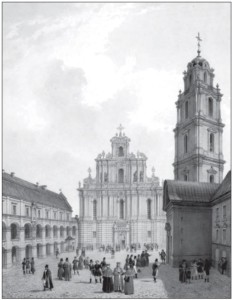
In the 1620s, Scottish units were also used in the war against Sweden in Livonia. Also, worthy of mention is that the great Lithuanian magnates, who owned vast estates, raised their own private armies, numbering anywhere up to 10,000 men. On occasion, such armies actually outnumbered the Royal Guard. One famous example of such a large private army was that of Jonušas Radvila, who in the 1650s, appointed a Scottish settler, from the magnate’s town of Kė- dainiai, commander of his army.
Professors and Students
The Jesuit Academy in Vilnius, founded in 1579, which was to be the forerunner of Vilnius University, became the home of British Catholic students and professors. The first native speaker of English who would teach at the new Jesuit University in the Lithuanian capital, would be Father James Bosgrave, who was born to a gentry family at Godmanstone in Dorset in 1547. He taught theology and mathematics before returning to the British Isles in 1580 as a missionary. However, his journey home was tracked by Queen Elizabeth’s network of continental spies, including John Rogers at Elblag. The same Rogers reminded the Virgin Queen’s henchman, Lord Walsingham, that the Palatine of Vilnius, Mikalojus Radvila Rudasis, was a friend to England. Bosgrave was arrested, but saved from torture and death only by the repeated intercession of the Grand Duke of Lithuania, Stefan Batory, who pointed out in early 1583, how Bosgrave was needed in Lithuania to further the cause of education there.
Among the other illustrious British teachers at the Jesuit Academy in Vilnius were the Scottish philosopher John Hay, S.J., and the Leicestershire-born Jesuit Father Laurence Arthur Faunt, who was professor of dogmatic theology in Vilnius in 1590. Faunt had studied in Louvain in 1570 and then went to Rome to study theology under Robert Bellarmine. He wrote numerous tracts regarding the conflicts between secular and religious authorities. Father Richard Singleton was another British Jesuit professor of philosophy and divinity; in the 1650s, and an Irish Jesuit, Father Edward Lock, taught logic in Vilnius.
However, there were many students from the British Isles who had studied in Vilnius. Four Scottish students were among those who wrote verse in 1604 in honor of the canonization of St. Casimir. British students at the academy had the opportunity to welcome Grand Duke Sigismund III Vasa in 1609. A piece of verse composed by an English student and published in the record of his visitation, Gratulationes a studiosa juventute Academiae Vilnensis Societatis Jesu facte, is the first English poem known to have been published in Lithuania.
Scottish and English Communities
Kėdainiai is a small town in the center of Lithuania. From its establishment in 1372, the town always entertained relations with other countries and religions. Throughout the seventeenth century, Kėdainiai was the center of the district of Samogitia, a province of the Calvinist Church administration of the GDL, and the residence of the Calvinist Superintendent of Samogitia. In 1627, Duke Kristupas Radvila guaranteed all settlers complete liberty of movement, and he encouraged foreign craftsmen and merchants to settle in the town. It was probably because of this invitation that in 1628-1629 a small Scottish community was formed in Kė- dainiai. Many believe they were brought to the town for mystical religious reasons; escaping wars in Scotland, they were in search of “the promised land” of Antillia—a kind of paradise on Earth where, according to the Scottish Calvinist Theologians Samuel Hartlib and John Dury, peace and Protestant authority would reign. Realists claim that the Scots settled in Kėdainiai searching for new markets. For that reason, the Lithuanian burghers of the town complained to the Grand Duke that the newcomer merchants from Scotland came to take their trade from them. However, Grand Duke Sigismund III Vasa could do almost nothing to defend the local townspeople, since the town was in private hands.
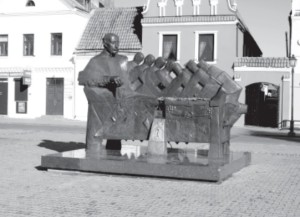
By the 1640s, the Scots had settled in the central part of Kėdainiai in the area surrounding the Great Market. Possibly 120 Scottish families (around 300 people) lived in the town during the seventeenth century. Before the destructive wars with Muscovy and Sweden in 1654-1660, Kėdainiai counted about 500 houses with almost 5,000 residents (while at the same time, Athens, the cradle of Western civilization had around 7,000 inhabitants), six churches of various denominations, six market squares and more than ten guilds, with more than 300 artisans. The Scots were often mentioned in written sources as the treasurers of the Reformed Church, tax collectors and seniors of the Church. Unlike in Poland, where the majority of the Scots were poor traders, their compatriots living in Kėdainiai were rich patricians and the town’s elite.
However, wars, economic crisis, various calamities and religious persecution at the beginning of the eighteenth century weakened the Scottish community in Kėdainiai and, before the partitions of the GDL, the community had practically disappeared. Most of the Scots had moved to Königsberg and Klaipėda in Prussia. Scottish merchants were active also in Vilnius and Kaunas, but their numbers (and activities) were insignificant, compared to Kėdainiai’s Scottish community.
The English also formed a community in the GDL when English merchants were invited to build a Lithuanian port at Šventoji. In 1679, Richard Brinley and his associates obtained a charter from Grand Duke Jan III Sobieski to build a port and trade out of Šventoji free from taxation for six years. The new name of the port was Janmarienburg, and by 1685 there were several dwelling houses and grain stores in Šventoji. The English had managed to develop trade with their neighbors, and the foreign merchants used to come to Šventoji. By the late seventeenth century, the port of Šventoji was known widely, rivaling the ports of Riga, Klaipėda and others on the Baltic Sea. Unfortunately, in 1701 during the destructive Great Northern War, the Lithuanian port was destroyed by the Swedish navy and the settlement collapsed when commercial activity proved to be unsuccessful.
In 1775, there were British plans to build a port at Palanga, “a miserable town” according to Nathaniel Wraxall, an English traveler who toured northern Europe at that time. But two decades later, Palanga would be in Russian hands, along with most of the rest of Lithuanian lands.
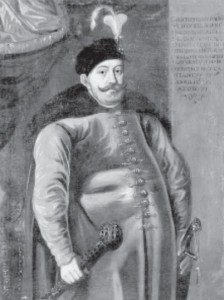
1640), by an unknown artist,
seventeenth century. He was
responsible for the establishment of
the Scots in Kėdainiai in 1628.
Conclusions
We have seen how the British presence in the GDL has developed over the centuries to include royal contacts, military activities and even the establishment of British communities in several Lithuanian towns. If there was migration from the British Isles to Lithuania four centuries ago, today the situation is different as thousands of Britons descend regularly on Vilnius, Kaunas and Klaipėda, this time not to settle permanently, but for tourism and business. British theater companies and orchestras also come very often to Lithuania to perform, while pop stars of a certain age play to large audiences in Lithuanian stadiums. Recently, the British Council has established an office in Lithuania to foster the teaching of English and cultural contacts between the two countries. In sum, contacts between both countries have developed over many centuries and are growing even stronger today.
 DRAUGAS NEWS Lithuanian World Wide News in English
DRAUGAS NEWS Lithuanian World Wide News in English
